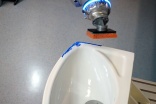Home › magazine › latest news › Washbasin cleaning robot can imitate human motions
Washbasin-cleaning robot can imitate human motions
10th of December 2024Robots are now capable of performing complex tasks such as cleaning a wash hand basin by learning from humans, according to scientists.
Innovative data-processing has been developed by a research team at TU Wien to allow robots to learn from humans and apply their knowledge to different situations.
Researchers have previously struggled with issues such as how to calculate the movement of a robot arm to enable it to reach every part of a washbasin. This becomes particularly complex if, say, the basin has unusually curved edges since it is hard to calculate the amount of force that needs to be applied where.
"It would be highly time-consuming to precisely encode all these parameters in fixed rules and predefined mathematical formulas," claim the researchers. "We have taken a different approach: a human shows a robot several times what it should do."
A specially-prepared sponge is initially used to clean the edge of a sink. By watching the human, the robot learns how cleaning works and can flexibly apply this knowledge to objects of different shapes.
The algorithm enables the robot to clean the entire sink and other complex surfaces even though it has only been shown how to clean a single edge of the sink.
"The robot learns that you need to hold the sponge differently depending on the shape of the surface and that you have to apply a different amount of force on a tightly curved area than on a flat surface," explains PhD student Christoph Unger from the Industrial Robotics group.
The technology can be adapted for use with other processes such as sanding down wood, repairing and polishing paint damage on vehicle bodies and welding sheet metal parts. And in future, the robot could even share its knowledge with other robots.









